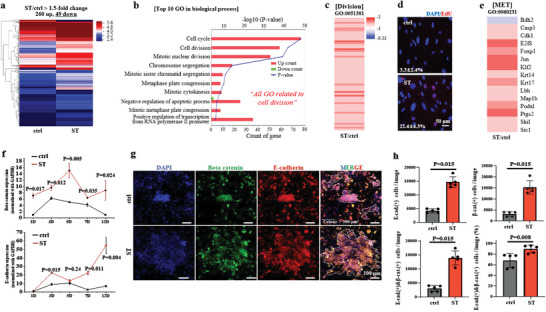Figure 2.

Cyclic stretch allows cells to feature enhanced biological activity for pluripotency acquisition, including increased cell division and mesenchymal‐epithelial transition (MET). a) RNA sequencing at day 2, revealing an overall transcriptome difference between groups, with 49 downregulated and 260 upregulated differentially expressed genes (DEGs) over 1.5‐fold change. b) Gene Ontology (GO) database analysis by DAVID with a total of 309 DEGs, showing the upregulated genes were mainly associated with cell cycle, cell division, mitotic nuclear division, etc. of top 10 biological processes, which highly correlated with the cell division, an essential biological activity for iPSC generation. c) Investigation of the genes related to cell division in GO, revealing that most of them were upregulated (over 1.5‐fold) by cyclic stretch. d) EdU staining of cells, confirming a higher DNA synthesis (cell division) by cyclic stretch, with an ≈7‐fold increase. e) Analysis of the genes related with MET in GO, showing that most of them were also upregulated (over 1.5‐fold) by cyclic stretch. f) Expression of epithelial markers (E‐cadherin and β‐catenin) recorded during the reprogramming process over 12 days, showing significantly higher levels in stretched cells. g) Immunostaining of cells for E‐cadherin (red) and β‐catenin (green), and DAPI‐co‐staining for nuclei at day 6, revealing a higher population of E‐cadherin(+) and β‐catenin(+) cells in stretched condition. h) Immunofluorescence‐based quantification of cells positive for E‐cadherin, β‐catenin, and both of them. Arrowed areas indicate colonies with an area exceeding 200 µm2, and the E‐cadherin/β‐catenin double‐positive cells were analyzed and presented in terms of both absolute numbers and fractions. Non‐parametric Mann–Whitney U test for (f) and (h). P values are noted in the graphs.
